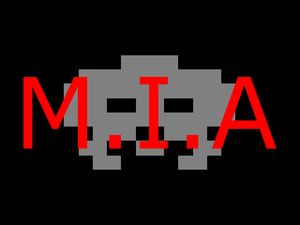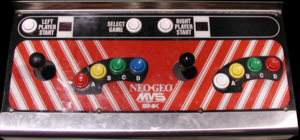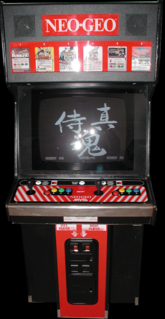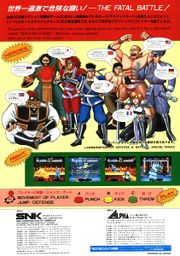Lost In Translation/World Heroes
| World Heroes | |
|---|---|
| Manufacturer | Alpha Denshi Co. |
| Released | 1992 |
| Control Method |
8-way Joystick 4 Button(s) |
| Main CPU | Neo-Geo 68000 (@ 12.000 MHz) Z80 (@ 4.000 MHz) |
| Sound CPU | Stereo YM2610 (@ 8.000 MHz) |
| Video Details |
Raster (Horizontal) 320 x 224 pixels 59.19 Hz 4,096 Palette colours |
| Screens | 1 |
| ROM Info | 21 ROMs 12,124,160 bytes (11.56 MiB) |
| MAME ID | wh1 · wh1h |
About The Game
World Heroes is a one-on-one fighting arcade video game featuring 8 heroes from different time periods compete to thwart Geegus, the evil alien end boss! Includes an extremely fun and unique death match mode!
Additional Technical Information
Players : 2
Control : 8-way joystick
Buttons : 3
=> [A] Punch, [B] Kick, [C] Throw
Trivia
Released in July 1992.
Hanzou Hattori is based on the real Hanzo Hattori Musashige (just like Hanzo in "Samurai Shodown").
Kotaeo Fuuma is based on the real Kotaro Fuuma Nobuyuki (1581-1603).
Kim Dragon is Alpha Denshi's homage to Bruce Lee (1940-1973).
Janne d'arc is based on the real Jeanne d'Arc who was burned in 1431.
Rasputin is based on the real Grigori Yefimovich Rasputin (1869-1917).
Muscle Power is most likely based on the real Hulk Hogan (b. 1953).
Jengis Carn is based on the real Genghis Khan (1162-1229).
The first World Heroes game is also the only game in the series where Kim Dragon is Chinese. He was then changed into a South Korean character for the rest of the World Heroes series.
Created during the years when "Street Fighter II" was at its peak in popularity, many dismissed World Heroes as another generic "SF clone." Though it has some unique concepts, the clunky controls and its "rip-off" reputation harmed sales. Due to this, the series was discontinued with World Heroes Perfect, although it has received a cult following, mainly around the Neo Geo fans.
The name of the Scientist who invents the time machine in the intro is Dr. Brown which might have been inspired by the character Dr. Emmett L. Brown (a.k.a. Doc) from the Back To The Future films.
Series
- World Heroes (1992)
- World Heroes 2 (1993)
- World Heroes 2 Jet (1994)
- World Heroes Perfect (1995)
Staff
- Producer & Director
- Kenji Sawatari
- Planners
- Kenji Sawatari
- Kimitoshi Yokoo
- Main Programmers
- TAT
- Marbo (Toshi)
- Yuji Noguchi
- System Programmers
- Eiji Fukatu
- Makio Chiba
- E-Chan
- Sound Programmer
- Makio Chiba
- Character Designers
- K. Hakamata
- Takashi Hatono
- Shinji Moriyama
- Hideyuki Yamada
- Sho No
- Muneki Shiraishi
- Kimitoshi Yokoo
- Hajime Suzuki
- Hiroyuki Toda
- Akira Ushizawa
- Hatsue Sakanishi
- Katsue Matsuzaki
- Rie Mori
- Giga.S (R. Nakajima)
- Koji Fujita
- Yasuyuki Sohara
- Atsushi Kobayashi
- Scroll Designers
- Kenichi Sakanishi
- Takashi Egashira
- Mitsunari Ishida
- Music & Sound Effects Composer
- Hiroaki Shimizu
- Hideki Yamamoto
- Yuka Watanabe
- Special Thanks
- Yukio Gotoh
- Tsutomu Maruyama
- Shinichi Tamura
- Mitsunari Ishida
- Ryu Hiroyuki
- Yuko Nishino
- Masato Mitsuya
- Hideki Miyakami (SNK)
- Koji Hamada (SNK)
- Hideki Fujii (SNK)
Cabinet and Artwork
Ports
- Consoles
- Nintendo Super Famicom (1993)
- Sega Mega Drive (1994)
- SNK Neo-Geo CD (1995)
Soundtrack Releases
| Album Name | Catalogue No. | Released | Publisher | Comments |
|---|---|---|---|---|
| World Heroes | PCCB-00106[1] | 1993-01-21 | Pony Canyon/Scitron | CD version. |
| NEO SELECTION - NEO-GEO Fighting Tournament Best / SNK.ADK | PCCB-00141[2] | 1993-12-17 | Pony Canyon/Scitron | CD version. |
| Samurai Spirits Drama CD | PCCB-00300[3] | 1998-03-04 | Pony Canyon/Scitron | CD version. |
| Gaesen Oh - Scitron Game Music Mega Mix Vol.1 | KGCD-0001[4] | 1994-01-01 | Pony Canyon/Scitron | CD version. |








